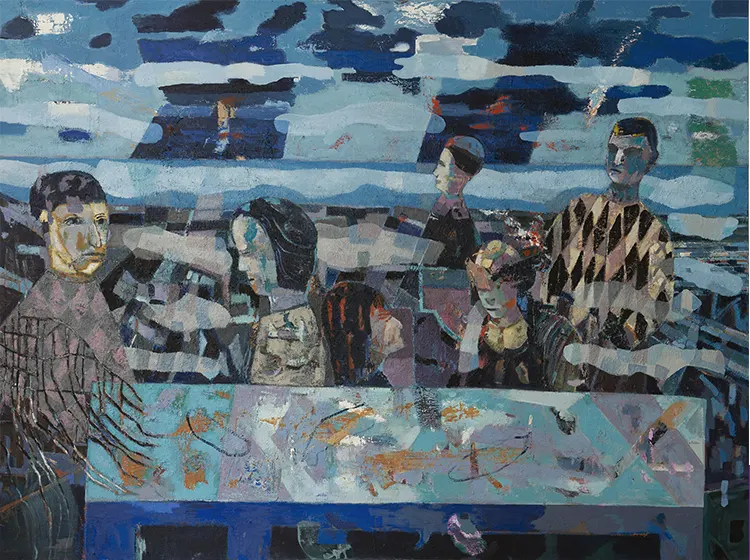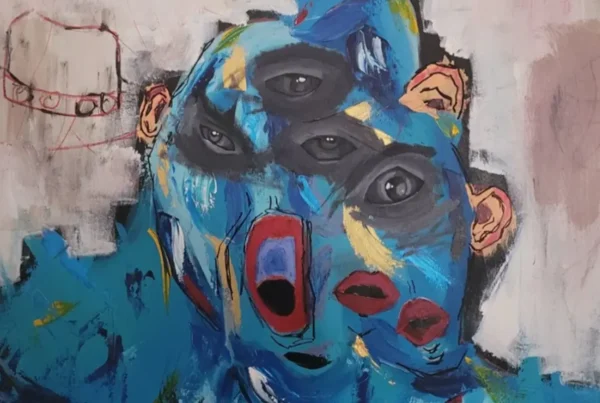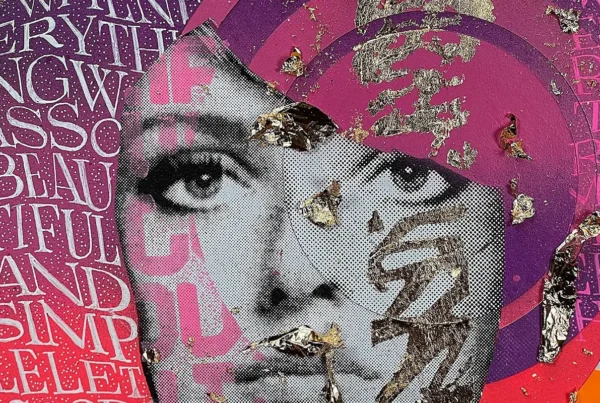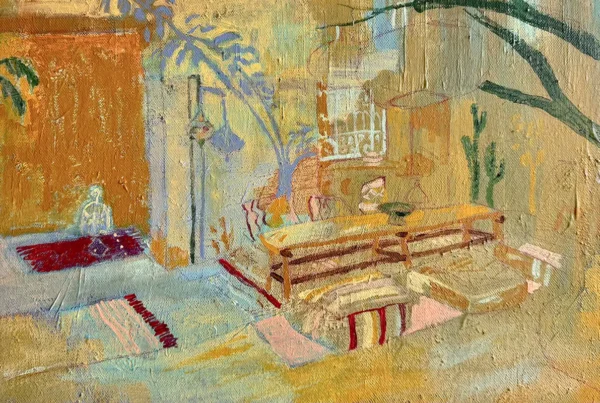“I bring references from far back in time and mix them with a more modern idiom.”
Erik Formoe: Nurturing Creativity and Connections in his Quaint Norwegian Hometown
Erik Formoe, an artist hailing from a quaint Norwegian town, finds his roots deeply embedded in the same place where he now maintains two creative sanctuaries. Now aged 70, he retains a strong connection with his birthplace, nurturing his artistic endeavors within its embrace.
Formoe’s early life was steeped in a devout religious setting, demanding his still presence at hours-long religious gatherings each week. In an effort to keep young Erik occupied and silent, his parents supplied him with sketchbooks and pencils. This seemingly small act nourished the budding seeds of creativity within him.
In their home, the Formoe family harbored a tenant who earned his living as an artist. Despite his less than exceptional talent, the tenant was quite successful and Erik frequently found himself drawn into the magnetizing world of the artist’s craft. He was captivated by the paint tubes, the easel, and the perpetual presence of drying canvases in the tenant’s living quarters. This early exposure ignited a spark in Erik, leading him to declare his ambition to become an artist at the tender age of 12. Despite their reservations, his parents watched him eventually step into the world of formal art education in Oslo some years later.
His formative educational years unfolded in the 70s and 80s, an era untouched by the convenience of mobile phones or computers. The emphasis rested heavily on the craft itself, referencing the annals of art history. The traditional painting techniques, the preparation of the canvas reminiscent of the Renaissance era, the hands-on experience of creating their own oil colors – all held paramount importance in their curriculum. At the art academy, a significant portion of their time was invested in working from models, while inspiration was sought from art museums and study tours across Europe.
Formoe’s personal artistic taste, even prior to his academic years, leaned towards French Impressionism, a movement he viewed as the genesis of modern painting. Throughout his artistic journey, he has striven to meld the disciplined compositions of the Renaissance with the effervescent color expressions unique to Impressionism. This pursuit has allowed him to shape his own distinctive visual language, drawing from these two divergent streams.
In his younger years, Formoe was particularly moved by the works of French Impressionists – Ce´zanne, Monet, and Manet. Their innovative approach of painting en plein air, directly facing their subjects, brought an unprecedented vitality to their art. Monet’s technique of converting brush strokes into points, creating an optical blend of colors to the viewer, and transforming the painting into an abstract surface upon closer inspection, left a deep impression on Formoe. This fascination ultimately led him to adopt a similar painting style, resonating with the Impressionists’ methods.

The Evolution of Erik Formoe’s Artistic Journey: Uniting Form and Line
Upon Erik Formoe’s initiation into the Oslo Academy of Arts, he was compelled to engage in model-based painting, a technique that necessitated a more structured approach to form and line, subsequently hindering his previous free-brushing methods. This evolution resulted in his palette veering towards more muted, darker tones. The primary focus became the delineation of shape, a transition that gradually stirred Formoe’s interest in the confluence of unbridled painting techniques with more rigid form. This fascination has remained a constant, shaping the progression and evolution of his artistic oeuvre over the past half-century.
Following an eight-year stint at the Oslo Academy of Arts, Formoe developed a sense of fatigue with the bustling city life and opted to return to the comforting familiarity of his hometown. His first venture upon his return was the establishment of a dual-purpose establishment that functioned as both a gallery to showcase his art and a workshop where he could continue to create. This move effectively marked the inception of Formoe’s professional career in the arts, a path he embarked on over four decades ago.
Over the years, Formoe’s thematic predilection has leaned towards painting portraits and assembling groups of individuals, not as specific characters but as everyday encounters, familiar yet unknown. His work is underpinned by the belief that every individual carries with them a tale waiting to be narrated. His audience, upon encountering these anonymous figures, are invited to construct their own narratives and impressions based on minimal visual cues that Formoe embeds within his works. In this context, each painting becomes a dialogue, a unique story crafted by the spectator, making every interpretation inherently distinct.
Formoe’s technique revolves around the delicate balance of revelation and concealment. As the orchestrator of this visual discourse, he carefully controls the degree of information divulged through his artwork. By integrating geometric forms, varying headpieces, or selectively omitting facial features such as an eye or a mouth, he crafts a sense of mystery and intrigue that disrupts the viewer’s gaze. This unorthodox methodology affords Formoe a peculiar freedom. He is able to manipulate form and color without the burden of exact representation, transforming his role into that of an enigmatic storyteller rather than a strict realist. In this light, Formoe’s painting practice is not an act of creating truths, but rather an ongoing exploration of visual riddles.

Erik Formoe’s Unique Contemporary Idiom: A Harmonious Blend of Eras
Erik Formoe imbues his artwork with elements borrowed from distinct eras, masterfully weaving these strands together to create a unique contemporary idiom. The compositional harmony and tranquillity reminiscent of the Renaissance era coexist with the vibrant color intensity, a hallmark of Impressionist works.
Formoe’s artistic journey began with a phase of intense engagement with landscape painting, during which he would often work en plein air. Over time, he began to incorporate figures into his work, seemingly drawing inspiration from the bustling café culture that was burgeoning at the time. The dynamic interplay between individuals soon became a source of fascination for him, leading to an increased focus on portraits over the last two decades.
Regardless of the shift in subjects, Formoe’s painting style consistently echoes the influence of previous eras. His portraits are marked by bold improvisations and a certain daring liberty in transforming the subject. Often using himself as the model, Formoe isn’t averse to dropping an eye, obscuring part of the face, or adorning the model in attire that affords him maximum artistic license. The artist’s primary aim is to encapsulate a certain mental state or evoke a fundamental ambiance, rather than create a faithful physical likeness.
Formoe’s proclivity for oil paints is tied to his formative experiences as a growing artist, particularly his interactions with other artists who favored this medium. The inherent characteristics of oil paints, such as their longevity and consistent color, also align with his artistic temperament. He appreciates the prolonged engagement that the slower drying time allows.
In terms of artistic influences, Formoe acknowledges the substantial impact of early Renaissance works, the Impressionist movement, and subsequent periods. He has a deep respect for varied forms of art underpinned by solid craftsmanship. His visits to art museums often lead him to the works of Vincent Van Gogh, an artist he holds in high esteem.
The proximity to Edvard Munch’s legacy, geographically and culturally, has also left a lasting impression on Formoe. His visits to the houses and studios where Munch created many of his significant works imbue him with a unique sense of connectedness. The inauguration of the new Munch Museum in Oslo, showcasing Munch’s work in an unprecedented light, further reinforces this influence.
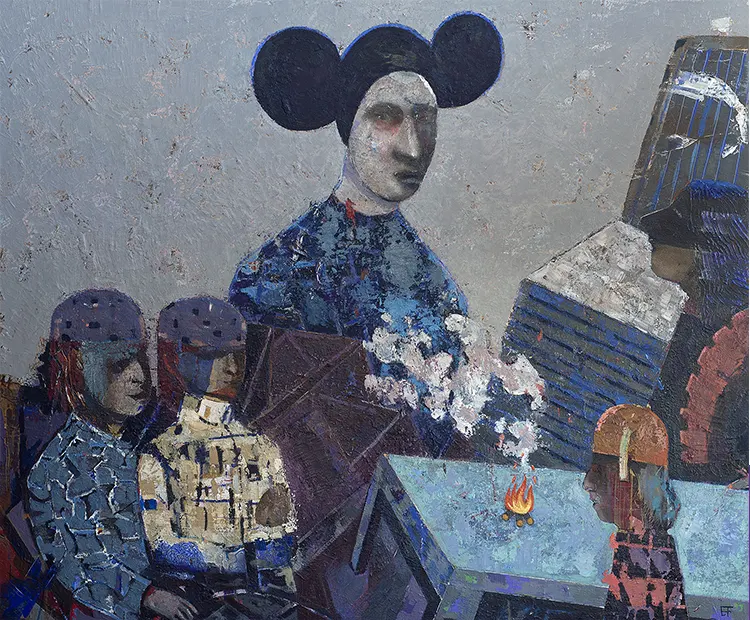
Finding Tranquility and Authenticity: Erik Formoe’s Artistic Pursuit
Erik Formoe cherishes tranquility and financial stability as essential elements of his optimal creative environment. He thrives in solitude, unhindered by interruptions during the meticulous execution of his art. An ardent advocate for creativity without constraints, Formoe has often found himself resistant to the pressures accompanying preparation for larger exhibitions.
In the recent past, illness has compelled him to decline numerous exhibition opportunities, fostering a period of reflection and introspection. Today, Formoe seeks to dedicate his time and energy to exploring novel motifs and visual expressions, unencumbered by external influences.
His heightened awareness of life’s fleeting nature has triggered an introspective shift, prompting him to focus solely on what truly ignites his passion and aligns with his artistic goals.
A particular artwork that resonates deeply with Formoe is a compelling portrait of Van Gogh, housed within the hallowed halls of Oslo’s National Gallery. As a twelve-year-old boy, he encountered this strikingly vibrant piece in solitude, its intensity forever imprinted upon his memory. Such was the impact of this portrait that it spurred him to delve into the life and oeuvre of Van Gogh, absorbing every detail from the artist’s letters to his turbulent relationship with Gauguin.
In Formoe’s eyes, Van Gogh’s short-lived but tireless artistic journey resulted in creations that were starkly authentic and unrefined — a rare attribute he perceives to be absent in much of contemporary art.
Projecting into the future, Formoe envisages a grand exhibition in an illustrious White Cube gallery. Here, he would showcase his finest 25 pieces, each artfully placed to command its due attention. Carefully curated, this exhibit would encapsulate 50 years of his relentless artistic pursuit. Alas, Formoe recognises this aspiration may remain unrealised, as his masterpieces are now dispersed across the globe.
